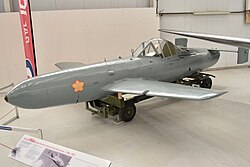Yokosuka MXY-7
| Yokosuka MXY-7 | |
|---|---|

|
|
| Type: | Rocket plane |
| Design country: | |
| Manufacturer: | |
| First flight: |
September 1944 |
| Production time: |
from September 1944 |

The Yokosuka MXY-7 "Ōka" ( Japanese 桜 花 , "cherry blossom") was a Japanese military aircraft designed for kamikaze attacks . The Allied code name for this manned glide bomb was "Baka" (Japanese for "idiot"). A five-part pink logo, which apparently symbolizes a cherry blossom, is painted on the front side of the bow.
history
The prototype flew in September 1944, and serial production began that same month.
There were a total of four different versions ( Ōka 11, Ōka 22, Ōka 33, Ōka 43 ), which differed mainly in terms of different drives. The cells were very simple and emphasis was placed on using materials that were as unimportant as possible to the war.
Usually the Ōka was carried near the target by a Mitsubishi G4M or a Yokosuka P1Y Ginga (type 22) and released there (the planned heavy bomber Nakajima G8N Renzan in transport version 43A / B should also be used for this). The pilot tried to get as close as possible to the target while gliding, in order to then ignite the rocket engines and pounce on the target. Nevertheless, the attacks were unsuccessful: the mother planes were vulnerable on the cruise flight and the flying bombs were vulnerable on gliding flight, and in order to maneuver successfully during the rocket-propelled flight, the pilot would have had to have a lot of experience, which normally was not the case.
Under the name MXY-7 Ōka K1, 45 training aircraft were built that carried water ballast instead of a warhead. They could land at 222 km / h with an extendable runner.
commitment
During the first mission, all mother aircraft were destroyed, not a single target was damaged. In a total of three months of operation until the end of World War II , one ship was destroyed by the Ōkas (the American destroyer USS Mannert L. Abele ) and several others were damaged.
Technical specifications
| Parameter | Ōka 11 | Ōka 22 | Ōka 33 | Ōka 43 |
|---|---|---|---|---|
| crew | 1 | |||
| length | 6.01 m | 6.88 m | 7.19 m | 8.16 m |
| span | 5.00 m | 4.11 m | 4.99 m | 8.99 m |
| height | 1.15 m | 1.12 m | 1.15 m | 1.12 m |
| Empty mass | 440 kg | |||
| Takeoff mass | 2140 kg (2060 kg loud) |
1450 kg | 2300 kg | 2520 kg ( Ōka 43A ) 2270 kg ( Ōka 43B ) |
| drive | three solid rocket type 4 Mk.1 model 20 | a Tsu-11 air jet thermal jet engine | an axial jet engine Ne-20 | |
| Thrust | 3 × 270 kp | 220 kp | 475 kp | |
| Top speed | 650 km / h in gliding, 370 km / h in gliding flight |
450 km / h | 650 km / h | 595 km / h ( Ōka 43A ) 555 km / h ( Ōka 43B ) |
| Fall speed | 912 km / h with drive at an angle of 50 ° | ≈900 km / h | ||
| Summit height | 8000 m | 8500 m | ||
| Range | 88 km (60 km loud) | 160 km | 210 km | 200 km ( Ōka 43A ) 270 km ( Ōka 43B ) |
| Armament | 1200 kg warhead | 600 kg warhead | ||
See also
- Kaiten - manned torpedo with a similar use
- Reichenberg device
- List of aircraft types
literature
- Srecko Bradic: Yokosuka MXY-7 Ohka - the deadly cherry blossom. and Uwe W. Jack: Ohka rocket bomb - the technology. In: Fliegerrevue X No. 81, PPV Medien, Bergkirchen 2020, ISSN 2195-1233, pp. 34–65.


